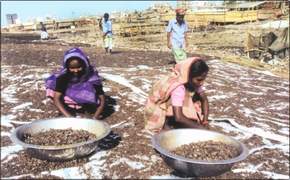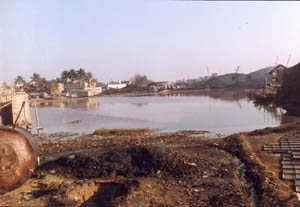Poultry feed churned out from tannery waste
Top of page DANGEROUS MIX: Women workers attend to tannery waste drying in the sun in Hazaribagh tannery district. The waste is ground with chemicals and sold as chicken feed, exposing people to serious health hazards.
DANGEROUS MIX: Women workers attend to tannery waste drying in the sun in Hazaribagh tannery district. The waste is ground with chemicals and sold as chicken feed, exposing people to serious health hazards.Experts warn of serious health hazards; government unaware of such business Tawfique Ali Traders in the city's Hazaribagh area are putting public health at great risk by producing poultry feed from tannery waste, keeping the government in the dark.
State Minister for Fisheries and Livestock Ukil Abdus Sattar told The Daily Star that he was unaware of such activities and that poultry feed production needed his ministry's approval. When his attention was drawn to the fact, he said he would look into the allegations. The director general of Bangladesh Livestock Research Institute, Quazi M Emdadul Huque, also said he was unaware of the practice. He said the technology for producing protein-concentrate feed was not commercially available in Bangladesh.
"It would be very harmful to public health if animal waste was widely used as raw material for poultry feed without being treated by the proper technology."
But the allegations continue to be made by various sources, who claim the practice has been going on for several years. They say tannery waste, along with dried fish dust and bone, is used to feed young broiler and layer chickens.
According to Dittfurth and Röhring (1987) about 250 different toxic chemicals and heavy metals like cadmium, chromium, arsenic, zinc etc. are used by the leather industry. When the local industry was basically a vegetable tanning complex, this effluent might have been high in BOD and unpleasant but particularly dangerous.
In 1977 the Government of Bangladesh imposed export duty on wet blue leather so that the industry produces crust and finished leather. With the ban on wet blue export from July, 1990, the leather industry of Bangladesh is entering into second phase of its development, the conversion of finished leather into further value added leather products to earn more foreign exchange. Promotion and Protection Act of 1980 provides protection of foreign investment in Bangladesh. There are German, Italian etc. joint venture plants are established in Bangladesh (M/S H. H. leather Industries Ltd, M/S BATA, M/S Lexco Ltd, M/S Apex Tannery Ltd).The operation in tanning which give rise effluents may be categorised into pre-tanning and post-tanning processes. Pre-tanning is employed mainly for the removal of impurities from the raw materials. These consist largely of protein (blood, hair, etc.) and the process chemicals employed include salts, lime and sulphides. The tanning processes themselves are used to alter the characteristics of skin or hide and their effluents contain chromium and vegetable or synthetic tanning. Post-tanning process include coloration and produce effluents typical of these addition processes; that is, containing residues of dyestuffs or pigments and larger quantities of auxiliary chemicals.
The process chemicals employed are a variety of inorganic and organic materials, affecting total solids, pH, COD and of particular importance are the applicable quantities of sulphide and of heavy metals. Hazardous chemicals for leather and dyes treatments are:Ammonium Bicarbonate, Chromic Acetate, Ethylene Glycol Monoethyl Ether, Methylamine, o-Nitrophenol, Toulene Diamine, 2,4,5-Trichlorphenol, Zinc Hydrosulfite, Zinc Sulfate, tert-Butylamine, Cadmium Nitrate, Cadmium (II) Acetate, Copper(2)Nitrate, 1,4-1,8 Dichloronaphthalene, Nickel Sulfate, o-Xylene, Zinc Nitrate etc.
The operation in tanning which give rise effluents may be categorised into pre-tanning and post-tanning processes. Pre-tanning is employed mainly for the removal of impurities from the raw materials. These consist largely of protein (blood, hair, etc.) and the process chemicals employed include salts, lime and sulphides. The tanning processes themselves are used to alter the characteristics of skin or hide and their effluents contain chromium and vegetable or synthetic tanning. Post-tanning process include coloration and produce effluents typical of these addition processes; that is, containing residues of dyestuffs or pigments and larger quantities of auxiliary chemicals.The process chemicals employed are a variety of inorganic and organic materials, affecting total solids, pH, COD and of particular importance are the applicable quantities of sulphide and of heavy metals.
For example Chromic Acetate shows the following characteristics (Sax, 1986):
- Potential for Accumulation: Positive
- Food Chain Contamination Potential: Positive, can be concentrated in food chain.
- Etiologic Potential: Chrome ulcer
- Carciniogenecity: Potential, higher occurrence of lung cancer
- Acute hazard Level: Extremely toxic if ingested or inhaled. Corrosive to living tissue.
- Degree of Hazard to Public Health: Highly toxic material via ingestion or inhalation. Corrosive to skin and mummer; potential carcinogenic (Anwar, 2003).
Leather Industry of Bangladesh
This correspondent saw a large quantity of solid tannery waste being sun-dried in the open along the Dhaka Flood Protection Dam near ZH Sikdar Medical College in Hazaribagh. At a factory in the area, a worker was found brewing a thick tar-black waste material in a drum-like container. He said he was preparing the raw material for poultry feed.
Staff at the factory, owned by Khalilur Rahman, said they could supply feed at Tk 650 a 50-kilo bag. Although attempts to contact Khalilur Rahman by phone were unsuccessful, a man introducing himself as a nephew said they used many materials, including tannery waste, to make poultry feed. He declined to respond to questions about materials, production or sterilisation technology.
The owner of Eastern Feeds Mills, Shariatullah, said his factory produces poultry feed from bones and animal waste generated by Hazaribagh tanneries. He said bone was boiled at a temperature of 130 degrees Celsius. When it was pointed out that tannery waste was seen being sun-dried for his factory, he replied: "It's not for poultry, but for fish, as it is not necessary to make the feed bacteria-free for fish."
An official at Eastern Feeds, Bishu Chowdhury, said they produce 200 to 250 tons of poultry feed a day. "We get the supply of steamed bone from Global Capsul, a pharmaceutical company in Barisal, to produce protein concentrate," Bishu said. The factory sells the product to Nahar Poultry in Noakhali and other farms. Bishu said the factory has certificates from the Veterinary Hospital, Department of Livestock Services and a science laboratory. He did not comment on the production technology.
Poultry feed made from waste material without proper sterilisation may contain bacteria, aflatoxin and other elements detrimental to poultry, said a source at Bangladesh Poultry Industries Association. "We are not aware of any such poultry feed industries in the country," said the source, who insisted on anonymity. "Our country does not have the kind of sophisticated and high-tech sterilisation mechanism required for making the feed bacteria-free and safe."
He said poultry industries usually use imported bloodmeal and bonemeal. Prof M A Latif of World Member Poultry Science Association also said he was completely unaware of animal protein-concentrate production in Bangladesh. He thought most supplies were imported from the United States. Unsterilised feed was a hazard and improper use of offal and other animal trash in poultry feed was detrimental to the health both of poultry and the public health, Latif said (The Daily Star, December 30, 2003).
In an editorial the Daily Star describes (31.12. 03):Toxic poultry feed A pressing public health concern Poultry feed is being produced through using tannery wastes without necessary treatment and sterilisation. The news has further lengthened the long list of public health hazards. Experts have pointed out that poultry feed produced from tannery wastes without sterilisation is harmful both to the poultry birds and consumers of eggs and chicken. So the magnitude of the health hazard can easily be gauged.
The problem stems primarily from the fact that poultry feed producers are not always using the scientific methods and not going by the health and hygiene standards. Poultry is a fast growing sector which contributes significantly to the economy. However, the latest finding shows that things are not being handled the way they ought to be in this area. The number of consumers of eggs and chicken is big and there will be an adverse impact on public health if toxic or contaminated substances are allowed to pass on to the consumers through poultry feed.
What is, however, most surprising is that the government department and ministry concerned have said that they are unaware of any such production of poultry feed. That only goes to show that there is no monitoring on poultry feed production. Now that the government agencies have come to know that poultry feed is being produced by some people in violation of health standards, they must act swiftly to stop such production. Without question, public health and the interests of the poultry industry should be uppermost in the minds of the decision-makers.
The finding should also help them realise that better monitoring is needed for a sector like poultry which supplies protein to numerous people. Corrupt practices and the tendency to make extra profit at the cost of public health have to be curbed. It must also be ensured that the poultry feed producers, and all others working in this sector, become sensitised about the health hazards and do not violate the rules.
While the most polluted industries are decreasing in the industrial countries a rapid increase in more environmentally degraded industries (without effluent treatments) occurring in the developing countries. The economic development in Bangladesh is producing more landless people and at the same time the landless and jobless poor are gathering in cities slums. A typical example is Hazaribagh leather industry in Dhaka. The leather industry is situated in the midst of a densely populated residential area surrounded by slums, where people are living ignorantly in the one of the worst polluted areas in the world.
The untreated tannery waste is one of the most hazardous and toxic waste. Sterilization does not remove toxic substances and other methods to separate heavy metals and orgainic hazards are extremely costly and beyond the capacity of Bangladesh. The only solution is not to use tannery waste and the tannery should be responsible for the safe disposal of tannery hazards. It may be mentioned that already the ground water of this area is highly polluted by carcinogene heavy metals.At present in Bangladesh the tanner's basic wet process technique is to treat the stock with increasing concentrations of process chemicals using water as the carrier. In order to ensure full penetration of the thickest hide or skin in the batch, these concentrations are in excess of what is needed and the unabsorbed chemicals are discharged in the effluent, where they are a waste and cause expensive treatment problems.
While the Chemical companies in the Federal Republic of Germany, the United States, the United Kingdom, Switzerland, Spain and Italy provide short term training on the application of their chemicals, Whereas they do not provide any assistance how to treat toxic effluents that increasingly contaminate surface and ground water. Consultant provide technological transfer and management either on arm's length fee paying basis on assignment or financed by the World Bank, UNIDO, ITC or other United agencies.
Back to Environment
Back to Home Garden
Home
